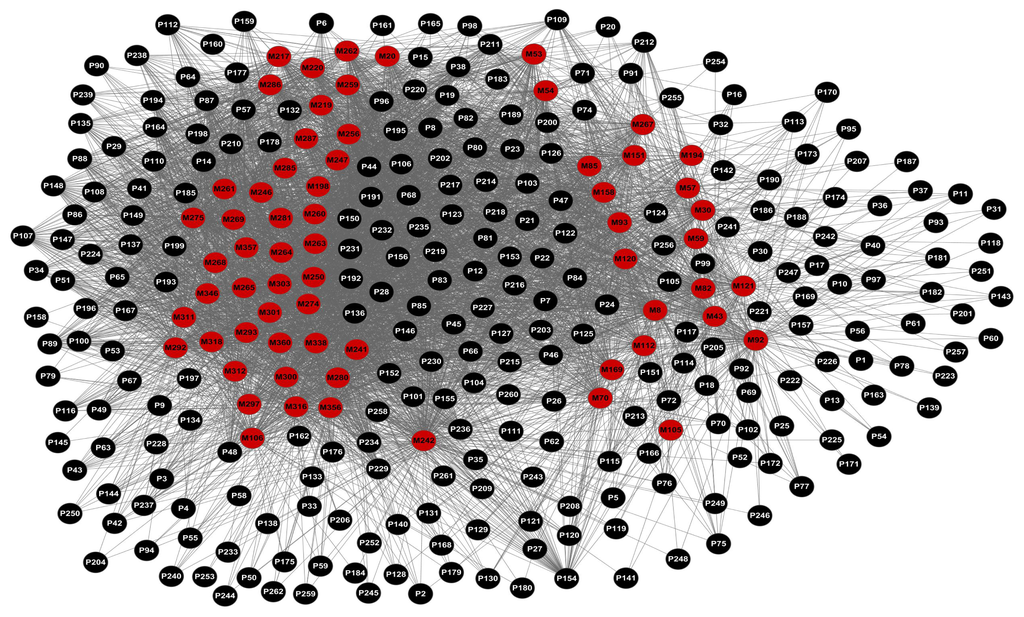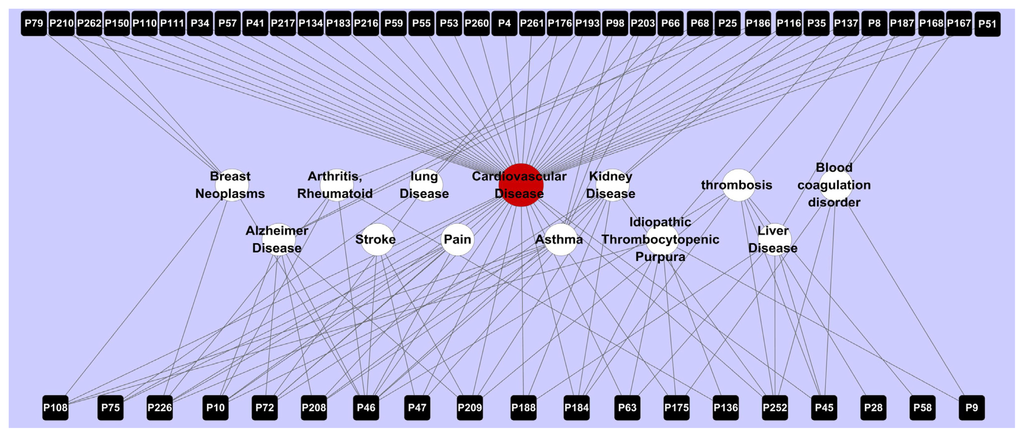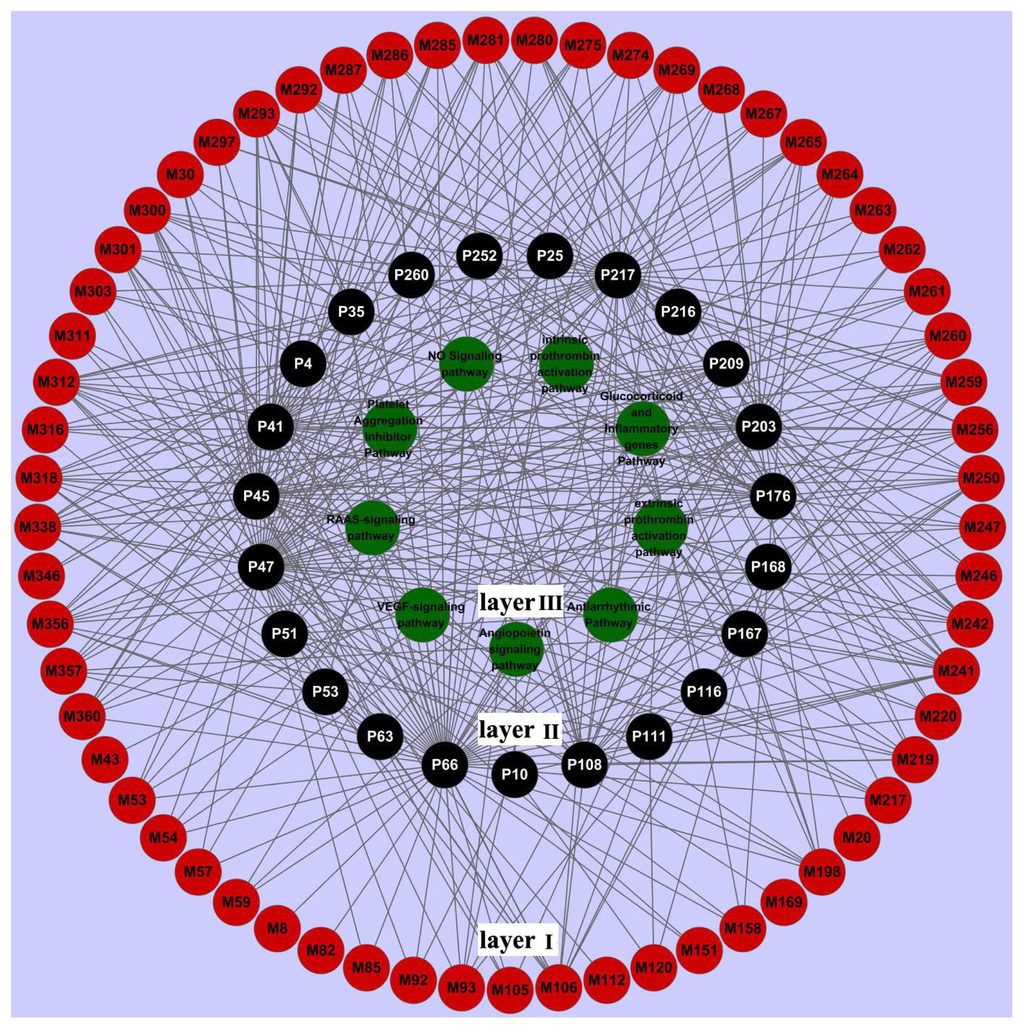
Figure 1. Network of 64 ligands (M) predicted to have 261 protein targets (P). The red nodes represent the ligands, while the black ones represent the proteins.
Figure 2. Network of 64 ligands (M, triangle, Layer I) predicted to have 54 protein targets (P, circle) after molecular docking validation. The black circles (Layer II) are the common targets of the three Chinese herbs Ligusticum chuanxiong, Dalbergia odorifera and Corydalis yanhusuo; the purple circles (Layer III) are the common targets of Ligusticum chuanxiong and Dalbergia odorifera; the red circles (Layer III) are the common targets of Ligusticum chuanxiong and Corydalis yanhusuo; and the blue circles (Layer III) are the common targets of Dalbergia odorifera and Corydalis yanhusuo. P9 (Layer IV) represent the protein target that is only identified for Corydalis yanhusuo(brown triangle); P34, P134, P184 and P186 (Layer IV) are only recognized by Ligusticum chuanxiong (pink triangle); and P75, P216, P252, P260, P261 (Layer IV) are only involved in Dalbergia odorifera (green triangle).

Figure 3. Network of 54 targets (P, black) connected to cardiovascular disease (red) and 12 other diseases (blank).

Figure 4. Network of nine signal pathways (green, layer 3) connected to 23 targets (P, black, layer 2). The ligands (M, red, layer 1) are linked to the targets.
Li, B.; Xu, X.; Wang, X.; Yu, H.; Li, X.; Tao, W.; Wang, Y.; Yang, L. A Systems Biology Approach to Understanding the Mechanisms of Action of Chinese Herbs for Treatment of Cardiovascular Disease. Int. J. Mol. Sci. 2012, 13, 13501-13520.
Abstract
Traditional Chinese Medicine (TCM) involves a broad range of empirical testing and refinement and plays an important role in the health maintenance for people all over the world. However, due to the complexity of Chinese herbs, a full understanding of TCM’s action mechanisms is still unavailable despite plenty of successful applications of TCM in the treatment of various diseases, including especially cardiovascular diseases (CVD), one of the leading causes of death. Thus in the present work, by incorporating the chemical predictors, target predictors and network construction approaches, an integrated system of TCM has been constructed to systematically uncover the underlying action mechanisms of TCM. From three representative Chinese herbs, i.e., Ligusticum chuanxiong Hort., Dalbergia odorifera T. Chen and Corydalis yanhusuo WT Wang which have been widely used in CVD treatment, by combinational use of drug absorption, distribution, metabolism and excretion (ADME) screening and network pharmacology techniques, we have generated 64 bioactive ingredients and identified 54 protein targets closely associated with CVD, of which 29 are common targets (52.7%) of the three herbs. The result provides new information on the efficiency of the Chinese herbs for the treatment of CVD and also explains one of the basic theories of TCM, i.e., “multiple herbal drugs can treat one disease”. The predicted potential targets were then mapped to target-disease and target-signal pathway connections, which revealed the relationships of the active ingredients with their potential targets, diseases and signal systems. This means that for the first time, the action mechanism of these three important Chinese herbs for the treatment of CVD is uncovered, by generating and identifying both their active ingredients and novel targets specifically related to CVD, which clarifies some of the common conceptions in TCM, and thus provides clues to modernize such specific herbal medicines.
Conclusions
TCM is a heritage that is thousands of years old and is still used by millions of people all over the world—even after the development of modern scientific medicine. Chinese herbal combinations generally include one or more plants and even animal products. This creates obstacles in identification of which ingredients in the Chinese herbs are active substances, as well as in the discovery of their targets. Additionally, the mechanism on the molecular/systems level of one of the most important theories in TCM, i.e. “multiple herbal drugs for one disease”, is still not clear.
In this work, we have constructed an integrated model of systems pharmacology by combining the knowledge of chemistry, biology and the theoretical background of TCM to investigate the mechanisms of action of Chinese herbs related to CVD. The obtained results show that the Chinese herbs Ligusticum chuanxiong, Dalbergia odorifera and Corydalis yanhusuo possess 64 bioactive ingredients in total, which significantly inhibit platelet aggregation and inflammation, and also exhibit great spasmolytic effects.
For the first time, we identified 54 protein targets, which are closely associated with CVD for the three Chinese herbs, of which 29 are common targets (52.7%), which clarifies the mechanism of efficiency of the herbs for the treatment of CVD. Also, this result indicates that the use of multiple drugs enables targeting the same targets simultaneously and thus exhibiting similar pharmacological effects on one disease. This helps to elucidate the mechanisms of “multiple herbal drugs for one disease”, one of the most important doctrines in TCM. This will provide more clues for the treatment of complex diseases and design of new combined drugs.
See more at:
Nenhum comentário:
Postar um comentário